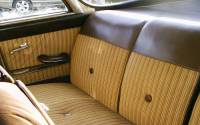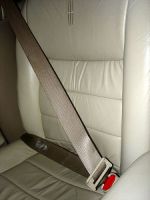How many times have you gotten out of a car after a long trip and experienced pain in your legs, back, or gluteus maximus? The pain is most likely due to the way you sat during your ride. The car seat plays a major role in keeping passengers comfortable and safe. Its purpose is to provide support, comfort, and safety while meeting the expectations of the public, the manufacturer and the government.
Introduction
The automobile, an unfathomable engineering feat at the turn of the twentieth century, is a familiar possession at the turn of the twenty-first century. But how many of us give our cars a second thought — other than when we buy gas? How often do we consider how our cars work and the engineering behind them? Furthermore how often do we wonder about the car seat and the engineering that goes into its design? We fall into them each day, buckle up and drive to work, school, or the nearest McDonald’s without giving those all-important seats a second thought (Fig. 1).
However, what if you did give it a second thought? What would that thought be? Would you wonder about what parts are in a car seat and how they are assembled? Would you consider how those parts provide a comfortable ride? Would you think about what advancements have been made since Ford’s Model T and what advancements we have to look forward to in the immediate future? Or would you worry about the safety that the car seat provides when involved in an unfortunate accident? Whatever your reason for wonderment about the car seat, learning about this everyday object promises to be a surprisingly interesting subject. The seat must provide proper support (ergonomic design), and be comfortable and safe [1]. Manufacturers can achieve these goals by beginning with good engineering design when considering various parts and how they are implemented to construct an automobile seat.
Parts and Assembly
The standard car seat is designed to support thighs, the buttocks, lower and upper back, and head support (Fig. 2). The front driver and passenger seats of most vehicles have three main parts: the seat back (squab), seat base (cushion), and the headrest [2]. These components are usually constructed from foam to provide comfort to the rider. When choosing this product, foam manufacturers must consider the most suitable foam for balancing comfort, support, safety, and recycling properties [1]. The cushioning agent is especially important when considering that moving cars can transmit vibrations near the human spine’s resonant frequency of 3 Hz [3]. The base can usually be moved forward and back on metal railings and may move up and down to adjust to different body types. This movement is accomplished either by manual latches or by electric levers. The base may also be equipped with a release lever to allow the squab to lean forward to permit access to back seats in two-door automobiles. The bottom of the squab is connected to the rear of the base and the release lever unlocks the squab from the upright position and allows for the afore-mentioned leaning. The standard base span is from the seated rear to just before the knees and the typical squab extends to the shoulders on the average height person. The head support is connected to the top of the squab by two metal circular tube shafts that are permanently attached to the head support and slide into two holes in the squab.
When sitting in the car seat your posture is the most important factor when considering your comfort. The positions that drivers assume depend on their anthropometric characteristics, the range and type of adjustments available in the seat package, and each driver’s preferred driving position [4]. Common available adjustments deal with concerns such as providing legroom, supplying back support, and giving head support. Available amenities include electric adjustments, choice in fabric covering, and temperature control. Important advancements in this area are of top concern to manufacturers, government officials and, of course, consumers.
Advancements
The chief concern of most manufacturers, along with safety, is the comfort provided by their design. Manufacturers compete to be considered the most luxurious and to set the standard in ergonomic seat design. Comfort is very important to consumers: 5% of the population suffers from back pain at any given time and 60-75% will experience a back ailment at some point in their life. Steve Reinecke, co-inventor of the patented BackCycler CPM(tm), explains, “Any position you sit in will become uncomfortable over time. His invention, the BackCycler CPM(tm), inflates and deflates to change the lumbar support the seat provides for your back on a normal interval to stimulate different muscles to do the work of carrying the load in your back. The BackCycler CPM(tm) has three main components:
- A seatback cushion containing an inflatable accordion-type bladder that holds a max of two liters of air.
- A microcomputer-controlled and pneumatic diaphragm pump enclosed in an acoustically sealed chamber under the seat.
- A tiny, user-operated control unit.
Ergonomics Inc. develops this device and plans have been made to integrate it into Volvo’s seats and instrumentation [3].
Another comfort advancement deals with a personal seat climate control system. A climate controlled seat module or CCS. A CCS can dispense noticeable cool or warm air to the dorsal sides of passengers in less than 30 seconds after activation. The CCS consists of three main parts:
- A Thermoelectric heat pump consisting of two 1.57 inch-square Peltier Junction modules.
- A 30-cfm-capacity fan
- A relatively simple electronic monitoring and controlling system
The heating and cooling of the seats occurs through both convection and conduction. Air passes through unique channels formed in the foam seat back. These channels allow the heated or cooled air to spread throughout the seat. Additionally, a thin 20 pore-per-inch layer of reticulated foam is sandwiched between the cushion and the seat fabric to allow the occupant to feel the air. This product is foreseen in the installation into electric cars. Since these vehicles can ill afford to divert 4,000 to 6,000 Watts to a climate-control system, the 110 Watts of input electricity needed to run each system is optimal [3]. A marvel in seat design is BCAM International’s innovation recently installed into Cadillac automobiles: the world’s first “intelligent” passenger car seat. This breakthrough in ergonomic design technology does not just deal with the traditional adjustments of the lumbar support area. A computer installed in the squab controls the contour of the entire seat surface automatically. The Intelligent Seat provides custom fit to each passenger in the vehicle. When a new occupant sits in the car, the Intelligent Seat recognizes the person and adjusts the seat to best fit the individual by providing the proper lumbar, thigh, and bolster support while improving the distribution of pressure caused by the occupant’s body weight on the seat. The system is dynamic and checks the comfort of the occupant every couple of minutes, and if need be, adjusts the seating surface, providing extended comfort during long drives. These automatic, adjustments enhance comfort by measurable levels and achieve a new standard in seat design.
Safety
An integral dimension to any seat design is the aspect of safety. As government regulations become more comprehensive, the design of the car seat must deal with more than just seat belts. Positioning of the occupant with respect to the steering wheel must be considered so injury is not caused by the steering wheel or air bag in a collision. Now, car manufacturers must try predict car driver size and position to enhance safety in crashes. Occupant protection systems must find information about the driver’s chosen seat position and the size of the driver especially if they are exceptionally large or small [4]. Engineers have gone through a series of tests to determine whether it is possible to determine driver position to boost safety. This process involves installing sensors in seats, utilizing specific CAE (computer assisted engineering) software for numerical evaluations, and experimental tools for laboratory test rigs and road tests [1]. Test results proved it possible to determine drivers’ head and chest positions relative to potentially injurious elements such as the steering wheel and airbag; it is even possible to determine some physical dimensions of drivers [4]. Knowing the dimensions of the driver assist the manufacturer in designing the car seat to provide the maximum possible safety as well as the utmost in ride comfort.
Conclusion
In this world that craves more, better, and faster in every possible facet of life, cars are no exception. Consequently, to bolster financial power and status new cars have more horsepower, better acceleration and hefty torque. However these conveniences do not assuage discomfort when stuck in traffic. The car seat is not a simple amenity in your vehicle; it is a complex system of parts assembled to provide comfort, support, and safety to the growing number of drivers in this world. Advancements in the design of the seat that enhance these concerns are taking place constantly in the field of engineering. So, the next time you take the wheel of your vehicle try to appreciate the engineering involved in all aspects of your car seat.



